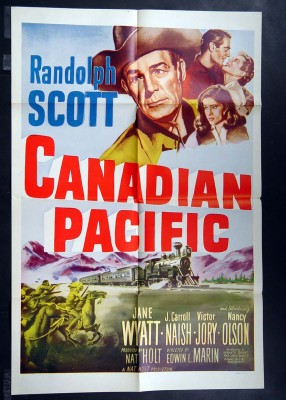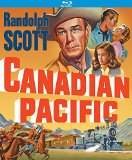| Reviews & Columns |
|
Reviews DVD TV on DVD Blu-ray 4K UHD International DVDs In Theaters Reviews by Studio Video Games Features Collector Series DVDs Easter Egg Database Interviews DVD Talk Radio Feature Articles Columns Anime Talk DVD Savant Horror DVDs The M.O.D. Squad Art House HD Talk Silent DVD
|
DVD Talk Forum |
|
|
| Resources |
|
DVD Price Search Customer Service #'s RCE Info Links |
|
Columns
|
|
|
Canadian Pacific
Still, it's big, colorful, with plenty of action, and features actors Jane Wyatt, J. Carrol Naish (particularly), Nancy Olson, and John Hamilton is atypical parts.
Cinecolor, meanwhile, was the popular, less expensive alternative to three-strip Technicolor during 1945-52, before the advent of more practical Eastman Color. Popular especially with B-Westerns, the bi-pack color process produced vibrant reds, blues, and flesh tones, while muting other colors such as green and purple, and generally giving everything a rustic brown ambience. Few Cinecolor titles have been properly restored, so modern audiences rarely have had the opportunity to see just how effective it could be. The restoration team seemed to encounter greater challenges on this than The Cariboo Trail, which to my eyes at least looks a notch or two better than Canadian Pacific, though visually their work here is still pretty remarkable.
Canadian Pacific is a railroad-building Western, with Scott playing chief surveyor Tom Andrews. Its archetypal plot has Tom searching for a pass through the Canadian Rockies so that the Canadian Pacific Railway can reach Canada's west coast. Opposing its construction is Dirk Rourke (Victor Jory), a monopolistic trading post operator whose business is threatened by the opening of the land. He convinces a band of fur traders, longtime residents of the region, along with several local tribes of Indians, to sabotage the laying of the rails.
Meanwhile, Tom's much younger girlfriend, Cecille Gautier (Nancy Olson, making her starring debut) is torn between loving Tom and loyalty to her trapper father (John Parrish), who sides with Dirk.
As Tom unloads cases of dynamite, Dirk shoots the whole lot in a spectacular explosion. It would first appear that Tom has been blown to bits, but as demolitions expert (and traditional Western sidekick) Dynamite Dawson (J. Carrol Naish) explains, Tom ironically survives because he was too close to the explosives. He is, however, critically injured, requiring months of hospital care under the guidance of pacifist female doctor Edith Cabot (Jane Wyatt). (Stretching credibility, he suffers no visible burns or permanent scars whatsoever.) Eventually the two fall in love, but she pressures Tom to give up his gun.
Commendably, the movie keeps its audience guessing whether he'll end up with Cecille or Edith, and there are slight hints that in pairing Scott with Olson, the producers might have been thinking a screen pairing along the lines of Humphrey Bogart and Lauren Bacall. Nancy Olson was barely 20 years old when she made Canadian Pacific while Scott, at 51, was more than twice her age, comparable to the age difference between Bogie and Bacall. Olson wears a hairstyle identical to Bacall's at the time, and her pale blue eyes aren't far removed from Bacall's green. Attempts to fashion Olson in the Bacall mold, if that's what it was, didn't get very far, however: intelligent as Bacall, Olson next appeared in Billy Wilder's Sunset Blvd. (1950), was nominated for an Academy Award and her career took a different path.
Though of Irish descent, J. Carrol Naish rarely played Irishmen. Instead he was cast as just about everything else - Arabs, Latinos, Chinese, Italian, American Indians - but a grizzled jovial Western sidekick was a stretch even for him. He pulls it off adequately enough, in make-up and costuming uncannily similar to Edmond O'Brien's look in The Wild Bunch (1969).
Canada's first woman doctor, Emily Stowe, began practicing medicine in 1867, so Wyatt's doctor in a story set in the 1880s is not unreasonable. Typically cast as devoted wives and mothers, it's a little unusual seeing her play such a liberated character, even a devoutly pacifist one. Likewise, it's a bit strange to see John Hamilton, best known for playing blustery, sometimes shady authoritarian figures (e.g., Perry White on TV's Superman) cast here as a soft-spoken Catholic priest.
Canadian Pacific impresses in terms of its production: lots of action, big Indian-trappers vs. railroaders shoot-out at the climax, beautiful scenery, and authentic vintage locomotives and railcars courtesy the real Canadian Pacific Railway. Scott, as he almost always was, makes a strapping, handsome man of action. Only the decidedly politically incorrect depiction of Native Americans disappoints here, they depicted as naïve dupes of Dirk's machinations. In one particularly embarrassing scene, Dynamite escapes an Indian ambush by passing off his namesake as jumbo cigars, he delighted upon witnessing a quick succession of off-screen ka-booms.
Video & Audio
Canadian Pacific, together with Kino's simultaneous release of another Randolph Scott Western restored by the same folks, The Cariboo Trail, are by far the best Cinecolor has ever looked, though Canadian Pacific is clearly the weaker of the two restorations. It may not quite have the full-bodied richness of Technicolor's three-strip process, but it's startlingly good at times, this despite the many challenges the restoration team faced (bad splices, missing and damaged frames, etc.). The picture's penultimate shot is in black-and-white, due to missing elements. The 2.0 DTS-HD Master Audio (English mono) audio is also excellent, and the disc is region A encoded.
Extra Features
Supplements include the aforementioned "Recombining and Restoring Two-Strip Cinecolor Components," which runs a full hour and goes into impressively exhaustive detail with many before and after, side-by-side comparisons. (There're also a lot of text pages, suggesting this was adapted from a German featurette.) Also included are abridged 8mm and excerpts from the 16mm versions of the film, and a trailer.
Parting Thoughts
A most welcome release, Canadian Pacific is Highly Recommended.
Stuart Galbraith IV is the Kyoto-based film historian largely absent from reviewing these days while he restores a 200-year-old Japanese farmhouse.
|
| Popular Reviews |
| Sponsored Links |
|
|
| Sponsored Links |
|
|
| Release List | Reviews | Shop | Newsletter | Forum | DVD Giveaways | Blu-Ray | Advertise |
|
Copyright 2024 DVDTalk.com All Rights Reserved. Legal Info, Privacy Policy, Terms of Use,
Manage Preferences,
Your Privacy Choices | |||||||














